In the meantime, why not read a little (okay a lot) about the man who started it all.
***
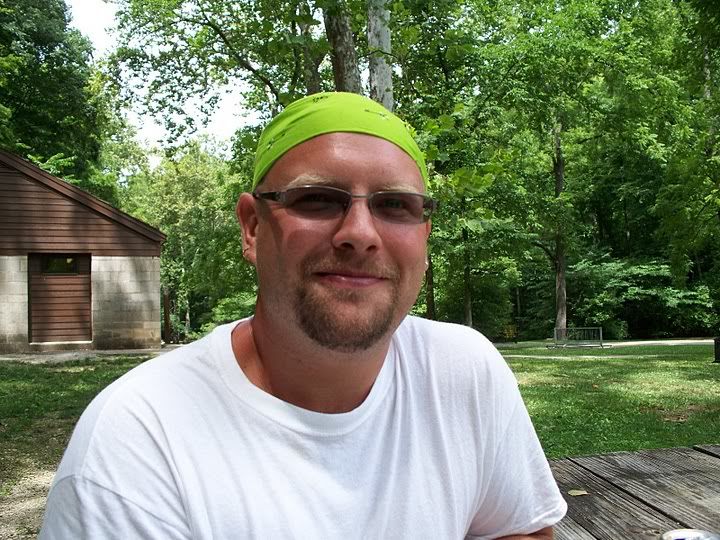
Alan, the man himself.
How did you first get interested in growing your own food?
I grew up on a tobacco farm. It is the farm on which I now live and has been in the family since my great Uncle Coydell Bishop.
Coydell experimented with many things including growing tomatoes and peppers for the local cannery that once existed in Pekin, Indiana. He, along with my grandparents, went so far as to purchase and perfect an unlabelled pink tomato that is now known as Bishop’s Big Pink. My grandparents, Doris and Alfred Bishop went on to purchase the farm where they raised chickens, corn, and White Burly Tobacco which at the time was a booming industry.
My parents, and later myself, helped my grandparents tend to the tobacco. I had a very close relationship with my grandparents and they taught me a lot of intuitive things that I use now on the farm. I also inherited my first tractor, a Ford Jubilee, from my grandfather. A favourite pastime and love of my grandparents was gardening. They always had a garden of a half acre or larger that I helped plant and tend. The garden usually contained corn, summer squash, winter squash (normally Hubbard explaining my love of Hubbard squash), tomatoes (Bishop’s Pink, Rutgers, Jubilee, all of which we still grow today) and more. My grandmother saved and replanted, occasionally even traded, much of her seed.
My favorite “growing” memories with my grandparents were my grandfather planting sugar baby watermelons at the end of the tobacco rows for consumption during cutting season as well as occasionally planting cantaloupes. Nothing was better on a hot day carrying tobacco sticks down long rows as a child than fresh melon. Of course my grandfather also taught me about the value of Ginseng and cultivating wild edibles, two skills which I am currently still using on the farm. The depression and war, and my grandparents’ experiences growing up in the hills of Greensburg Kentucky, were deeply ingrained in me. To this day, I remember their stories about their childhood as though they are my own memories. Kim (my fiancée) and I have often remarked that should the opportunity be provided then Greensburg would be the location of our own homestead.
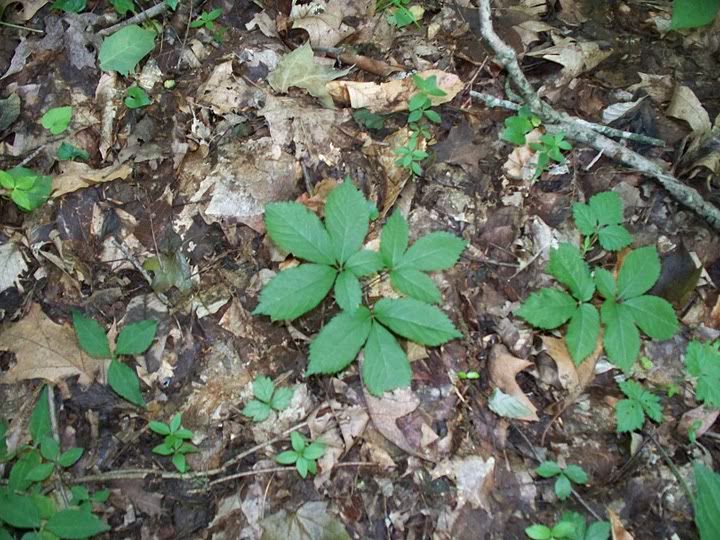
Ginseng
On my mother’s side, there were also many gardeners. I have fond memories of visiting family in Clay County Kentucky as well as Washington County, Indiana and their vast gardens. I remember my Grandfather Wilson’s stories about raising Pencil Cob corn on the Red Bird River and Shepard’s Branch near Oneida, Kentucky using a double bottom plow pulled by mules. I remember my mother’s parents having a hedge of gooseberries planted outside their back door and eating and eating those beautiful little berries until I got sick. Hoskins-Barger Yellow/Pink was a family gene pool tomato that I received from my mother’s Aunt. The tomato originally arrived here from Oneida, Kentucky.
In high school, I took several Ag related classes taught by former students of Purdue University, both animal and plant related classes. I had the advantage of attending a school complete with a greenhouse as well as advanced college credit classes. While many students were abusing the system and using Ag classes as an easy grade, I was immersing myself in it and learning as much as I could about agriculture, even if the consensus in those classes meant that industrial agriculture is all that was discussed and endorsed. I learned many propagation methods there as well as learning about many systems of irrigation and harvest. I steered clear of things like FFA (future farmers of America) mostly because I didn’t fit into the category of people interested in those types of programs (the farmers son, 500 acres, chicken houses and a combine) and needless to say people such as them and myself didn’t necessarily see eye to eye. According to my parents, I was a bit of a wild child. It was around this time that we stopped raising tobacco but it was also at this time that I began my first breeding project called Robert Johnson White Burley Tobacco, as a fun experiment and as a tribute to my grandparents (this is why the cross was made between varieties originally grown here on the farm). At one point, I entertained the possibility of attending Purdue University but in hindsight I am glad I choose not to. I prefer to have an open mind and university methods do not encourage that.
While in high school, I became very interested in music and by the end of high school I had played in a number of local bands and recorded a number of songs. I had big dreams and wanted to escape my little town, those turned out to be pipe dreams. Later, I played with a relatively well known band for a while, but for my own health, spiritual and mental, I needed to make a change. Too many of the people around me were exhibiting behavior that was becoming irreprehensible to my personal values and I had become something that I didn’t feel was a true representation of what I could. Something called me home, back to the soil. During this time, my grandmother and I were very close. My grandfather having died in ‘93, she often expressed her disappointment in our non use of the farm (after ‘98 we stopped raising tobacco). She encouraged me to take up the reigns and do something here full time in the way that her and my grandfather had wanted to do but couldn’t (though they farmed my grandfather had worked a full time job previous to retiring). My grandmother’s death in ‘04 was the catalyst for returning to the farm.
I remember one moment in particular, on the morning of 9/11, when I had an awakening so to speak. Many people did, but mine was a little different. My generation had been so desensitized to such events that most didn’t really react; after all, we had been exposed to Ruby Ridge, Waco, Oklahoma City, Columbine and so forth. I remember thinking that in my lifetime there would be major changes and that all wasn’t as it appeared and that eventually I should “get prepared.”
I thought about that after I came back to the farm.
During my time as a musician, I worked in landscaping and landscape design and between the money I saved from both careers, as well as from my mother and father’s loving support, I purchased two greenhouses. My money was gone but I was into what I was doing in a way that is unexplainable.Often times when I look into something that interests me, it goes beyond ordinary interest, becoming a bit of an obsession. I have to learn all I can. I have to become what I study, and as such I immerse myself.In 2005, I found myself immersed. I began growing out many varieties of tomatoes and peppers and making crosses as well as selling at the local farmer’s market. All of my life, local and homegrown food had just been something that was always available to me. I hadn’t yet made the connection between actually growing it, selecting it, adapting it, and being connected to your food in the way that I am now. That didn’t happen until I had been separated from this farm for a few years as a musician. It was then, after my awakening, that I realized what I was missing, that I loved what I no longer had.
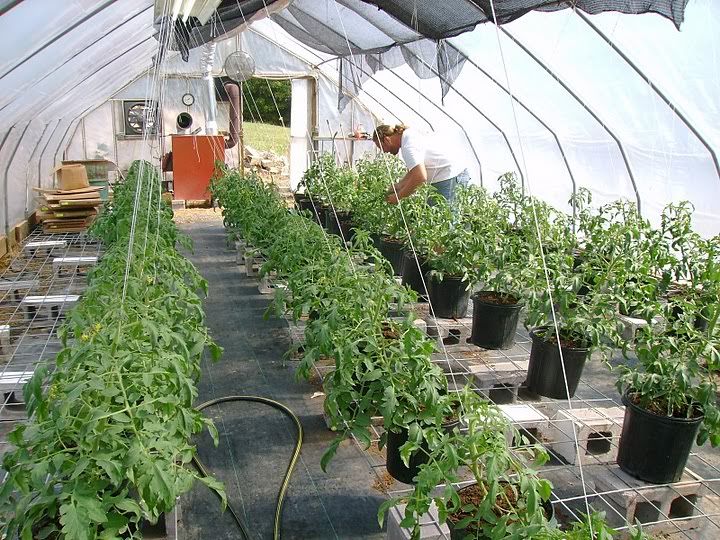
One of his greenhouses.
If you were to give me a tour of your farm, where would we start and what would I see?
That’s a really excellent question and the truth is it would probably change daily, at least seasonally. I’ve always got some big new idea or project I’m working on, whether it is a new piece of infrastructure or a garden layout. There’s always something. It never really feels complete here on the farm, and that’s one reason I love what I do. I am committed to it so completely.
Lately though I’ve been working on my veritable garden of Eden. It’s an overextension of my current orchard project. This past fall, I cleared about 1.5-2 acres of scrub forest on the back side of the farm, in an area that was once open field that my grandparents used for growing corn to feed their chickens. In this area, I am planting engrafted seedling trees of many fruit varieties in the name of diversity, curiosity, and selection and improvement along with Luther Burbank’s white blackberries, wild yellow and purple raspberries, and a ground cover of alpine strawberries. This area will also be a repository for Tim Peters’ many, varied perennial grains. I have also dug a small pond there. Right now there isn’t much to see there but in a few years, it will be beautiful.
My favorite place to be on the farm in the winter time is probably around the two turkey/guinea coops. I’m really proud of my birds. They have so much personality and they are so much fun to watch. In the early spring, the greenhouse makes for an excellent showing. While the grass outside is still brown, the warmth and the green coloration of the young plants in the greenhouse are quite inviting and striking in contrast.
If it were late summer/early fall, we would head out to the Astronomy Domine sweet corn patch to select seed and look at the beautiful husked ears of every hue of sweet corn seed you can imagine.
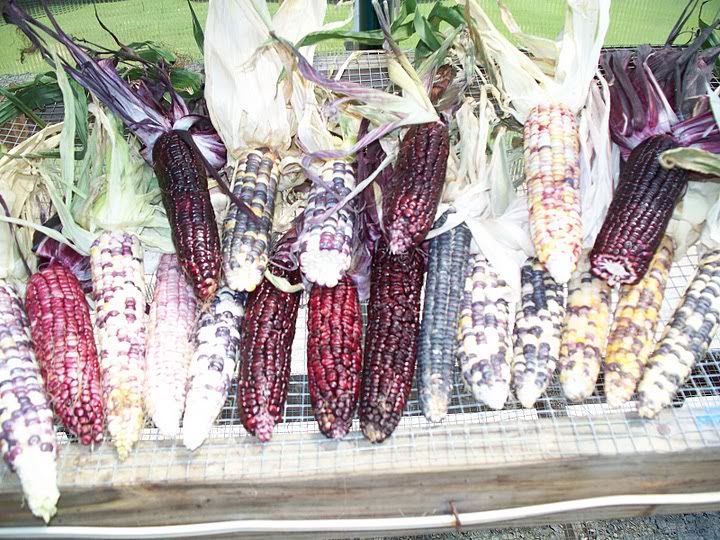
Astonromy Domine Sweet Corn
There is this little quarter acre area next to the house that I have trellised with cedar posts cut from our woodlot this season that are being used to grow many berry varieties. I have an obsession with using as many of the natural and sustainable resources around the farm as I can in my projects. They don’t always look aesthetically pleasing until they are grown over but it is good hard work and rewarding. I also have this thing about using/re-using all the junk laying around the farm. Four generations of one family on the same farm piling stuff into one old tobacco barn means there are many resources and lots of junk to utilize. It’s been part of my compulsion to alleviate this eyesore (it’s the only place that is actually cluttered on the farm) and many times I find useful materials for projects here. My rabbit hutches were almost all built out of scrap lumber, metal, and nails from the barn. Just yesterday I used a bunch of old guttering from my grandmother’s house. It had been lying next to the barn for several years now, and I got to thinking about how it would fit perfectly across the top of the cedar trellis systems and would be the perfect depth for growing alpine strawberries in the summer, not to mention that they would be in easy reaching distance for picking. I tacked up about 150 foot of the guttering system which will provide a lot of room for the diminutive alpine strawberry plants. They will freeze in the winter, but given their self seeding abilities, and my obsession with saving a few ounces of seed off of them every season, this will be fine. Besides they grow quickly and are easy to replace and I’m always making new crosses with them, attempting to select for larger size and develop them and their superior flavor into an alternative market crop.
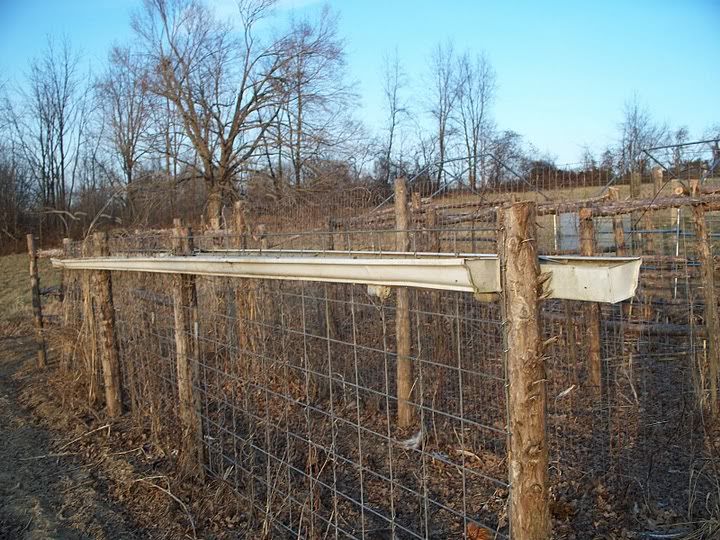
Cedar post trellis system with gutters for alpine strawberries
What is your current areas of interest right now?
So many of the things I am into are influenced by the world around me, particularly music, which still inspires me to do new things. This is why so many of my breeding lines are named after songs, albums, or musicians. I’m also highly influenced by history, various human cultures and so forth. I’m always reading, particularly about agriculture. I’ll learn something new that I didn’t know before and it just clicks like “I have to try that.” Terra Preta was like that. Alpine Strawberries were influenced by Jefferson having grown them. Trees from seed, though genetically unstable, resonated with me via Jonathan “Johnny Appleseed” Chapman, plus there’s that whole primordial “this is how agriculture probably started experience.” I always imagine that agriculture developed from cultures noticing that seeds were growing and thriving in midden heaps. That is the essence of humanity: Innovation.
At the moment, I’m really into turkeys. Plants will always be my first love but animals, particularly poultry and now rabbits, are a close second. I love turkeys, their personalities, colors, and most of all the striking poses they take as well as their meat qualities. Heritage turkeys, not the monstrosities they grow in overcrowded houses.
The Anasazi realized the value in these birds and to this day they are credited with initial domestication; I like that. There is something special about the way that they saw them as a sacred animal.
I’m very interested in breeding new color combinations, but mostly in improving feed to weight ratios and fixing size types.
Recently, I’ve been reading a lot about Beltsville Small White Turkeys and Midget White Turkeys, both were novel ideals which came a bit too late, coinciding with the rise in popularity by producers of broad breasted monstrosities. Both were almost lost completely. I have obtained new stock of both breeds, due to arrive this spring and already have the Royal Palms that were involved in the breeding of the Midget Whites. I converted my original Rion Hobby Greenhouse into a secondary turkey coop for my small type birds. My hope is to improve the breast meat of these birds and breed midgets in less predator prone colors than white. We have a bad problem with hawks here and so white, small type birds are sitting ducks (so to speak). I think that a Bronze, Black, Bourbon, or Blue midget with a wide breast would be of importance to a lot of producers.
Ideally, I want to have two flocks with one made up of large sized birds to act as a gene pool just like in most of my breeding projects. Then I want a second flock, another gene pool, but restricted to smaller sized birds. Not all families, particularly small ones, will want to eat a standard bronze sized turkey, some want a smaller bird.
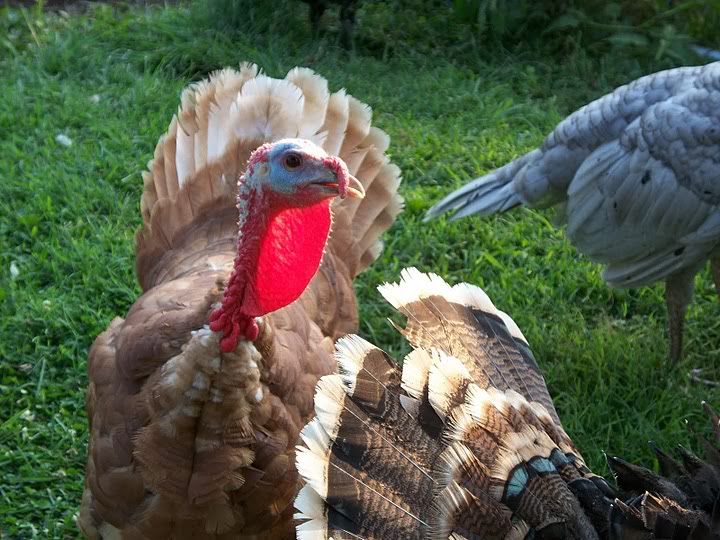
Some sassy looking turkeys
I’m also working with standard and French Guineas. French Guineas look just like pearls, but they get huge - 7 lbs. With a bit of light, they will lay year round like chickens. The issue is they don’t breed naturally, but by using a standard guinea cock bred to a French hen over a few generations, I can select for a naturally breeding, year round laying, French type guinea.Rabbits are new to me and I’m not sure where I’m going with them. It was the history of rabbits and French settlers in this area that got me interested. I’m growing for meat; in time I imagine I’ll breed some of my own unique stock.
Regarding plants, 2010 will see the stabilization of many lines of ongoing breeding progeny. Of particular importance to me is the release of my tomatoes - Absinthe and Jack White, Pac Man, The Pink Floyd and some others - to a seed company. I would also like to get the Astronomy Gene pool out there via a seed company. There are some squash vine borer and powdery mildew tolerant Hubbard squash lines, both large and small, (to go with your turkey?) in the pipeline, along with a very cool, nearly stable, Hip-Gnosis green fleshed cantaloupe, two lines of genetically diverse white fleshed watermelons and the dent corn; both gene pool OP types and nearly fixed varieties.
I’m always obsessed with seed varieties, scouring catalogues even long after I’m out of room to grow any more. I do a lot of gene pools in a search for diversity. In coming years, as mentioned above, I’ll be doing the uber important work of selecting fruit varieties from seed. We need new and better adapted fruit varieties, but we have been so discouraged by the “know it all” professionals from growing from seed. It’s no wonder we are loosing diversity.I like to read about and experiment with soil fertility. I’ve been raising red worms for several years now, but this year it’s bigger than ever. I have 12 full 4 x 4 x 4 wooden bins that have been fed variable feed stocks. Everything really, including meat, leaves, rabbit manure, chicken manure, goat manure, cow manure, horse manure, table scraps, leftover wine squeezing and yeast cakes, coffee, coffee beans, bakery leftovers, egg cartons (cellulose). Many of them have been fortified with Bat Guano and lime. Worms are a world all their own and so is soil fertility. I love talking about it. I enjoy the idea of building a soil, of building humus. We figured out that in the past 5 years, we have amended 5-6 acres of land with close to 40 tons of material. That’s a lot. My grandparents used a lot of organic matter but also used commercial fertilizers. When we started farming again after the 8 year lull, there were few worms. Now they are everywhere. There are so many, in fact, that unless the ground is frozen, the turkeys hardly ever eat any grain. I count that as a blessing, both in not having to feed them and in that a large earthworm population is a sign of fertility and that at every second of the day they are working my soil, fortifying it.
I like concepts. Words really. Sustainability, humus, naturally breeding, gene pool. Lot’s of them.
What do you see as the most important trend in edible gardening right now?
When I first started the message board and got into Open Pollinated/Heirloom seeds, a lot of people frowned upon what I was saying about making gene pools, about breeding new varieties with a wide genetic base. I tried to explain it to people then but they didn’t get it.
The concept to me was always a two edged sword. On one hand, you had the idea of genetic purity in seed strains, which on the face of it, strikes me as like Le Petit eugenics, but in some instances it is a good thing. The instances within which it is a good thing are those instances when one is growing a variety adapted specifically to their bio-region, climate, or more specifically their own garden.
The problem arises when we take a look at how few actually “regional” seed companies we have. Before the so called Green Revolution, we relied on these regional seed companies that sold seed adapted specifically to our environment - seed that we could count on. The heirloom movement came along and gave us tons and tons of diversity, which is a good thing, but with it came marketing seeds adapted to the Pacific North West or the South Western states to people on the east coast or in Canada or in the deep south where they will not grow properly without a struggle. You also have what we have come to call “seed snobs”, those obsessed with saving every variety of everything and keeping it completely “pure.” These people didn’t get me at all. I was being inspired by guys like Ken Ettlinger and Alan Kapuler; bio-diversity was the key to me, so I made a place for folks like me in my forum.

Cover of Deep Diversity Catalogue
So my thing was to find seeds adapted to your environment, preferably regional varieties that historically correspond to your area, where you are missing something in your seed list and where there exists no new variety then to breed a variety, particularly using gene pools and horizontal resistance selection. Here we get maximum diversity, and while it is not always a crop harvestable all at once, a trait useful mostly only to industrial agriculture anyhow, it works. You can select for a set of traits and create something stable and “pure” that has never existed before, or you can select for an open pollinating gene pool or grex of varieties. This is how we ended up with most of our heirloom diversity to begin with. Looking at the Native American varieties, we can see this kind of diversity in many of their crops such as squash that grow fruit of four or five types from one seed variety, a single watermelon type which makes red, yellow, and orange fleshed melons of all sizes or “Indian corn” as it is so called for all its various colors. At one time this was a gene pool.
The other thing is that many of our crops, our treasured heirlooms, particularly corns, are highly inbred to the extent that if we don’t do something we are going to loose them. I always say that sometimes the genes are more important than the varieties. So many gene banks and seed companies are dealing with inbred lines that we are going to loose all of those important genes if we don’t start gene pooling them and increasing their diversity and limiting in a major way their diversity.
So really, I think the most important trend in agriculture is this move towards the acceptance of amateur plant breeding. It’s only through this area of research in conjunction with organic methods that we will ever be able to develop useful alternatives to industrial agriculture for our communities.
Another thing I have noticed, more of in the past year, is the trend to move away from tomatoes as the uber important crop of interest. So many people are concerned with growing and maintaining tomato lines, understandable as it’s a popular and well loved crop that doesn’t take much room too grown, but we already have about 10,000 well known tomatoes, of which some many are probably very similar. A lot of people are interested in breeding tomatoes. I’ve moved away from it. It’s nice to see people getting into other crops, maintaining them as well as breeding new ones. It gives me hope, and I hope that in time we will see half as many new other vegetables being bred, maintained and released by individuals every season as we do tomatoes. Maybe I am biased when it comes to tomatoes though, I don’t think I’ve mentioned that I don’t eat them, and wouldn’t if I was paid! Is it strange for a Hoosier to not like the taste of tomatoes?
I think a lot of this change has come due to all the uncertainties in our world, both economic and political. I think it’s good that people are looking at regionalism and sustainability. It is probably time that we get ready for the worst, even if the worst never comes. The only way we will ever be able to continue to thrive as humanity is via experimental and sustainable agriculture.
The thing that gives me the most hope and the most inspiration are the numerous friends I have made in the world of agriculture, in person and via the internet. So many great friends have shared not just their diversity and knowledge with me, but their love and their friendship, and that is the greatest gift of all. One day, I dream of meeting them all in person, of sharing with them our hopes and dreams in person. It is because these people have put their belief and friendship into my work that I do what I do. This is the only place I have ever felt accepted in the world of agriculture. Even 10,000 years after we stopped stumbling around the wild simply hunting and gathering, we are all still a tribe. Part of me, the part that motivates me, is my love for almost all things and all people.
Alan Reed Bishop
***
Thank you Alan!
Hear more on his blog Bishop's Homegrown Goodness

1 comment:
Truly a gardener after my own heart - nice to get to know the guy behind the Homegrown Goodness board a little better! Thanks, OG
Post a Comment